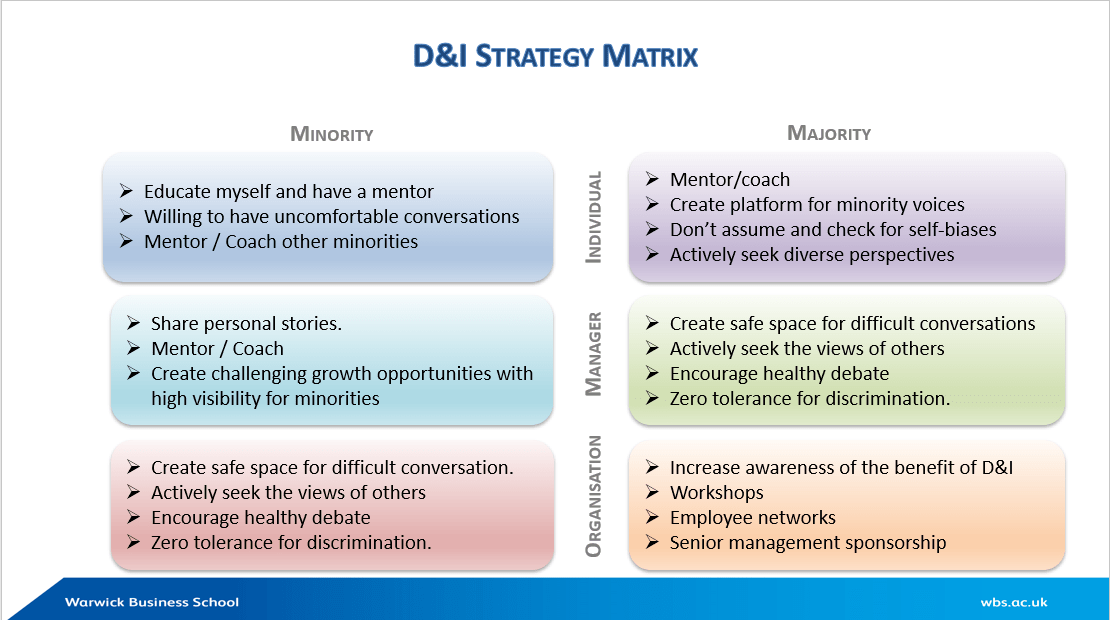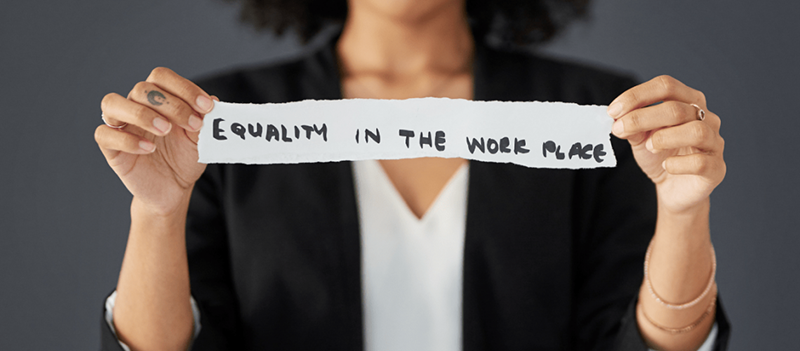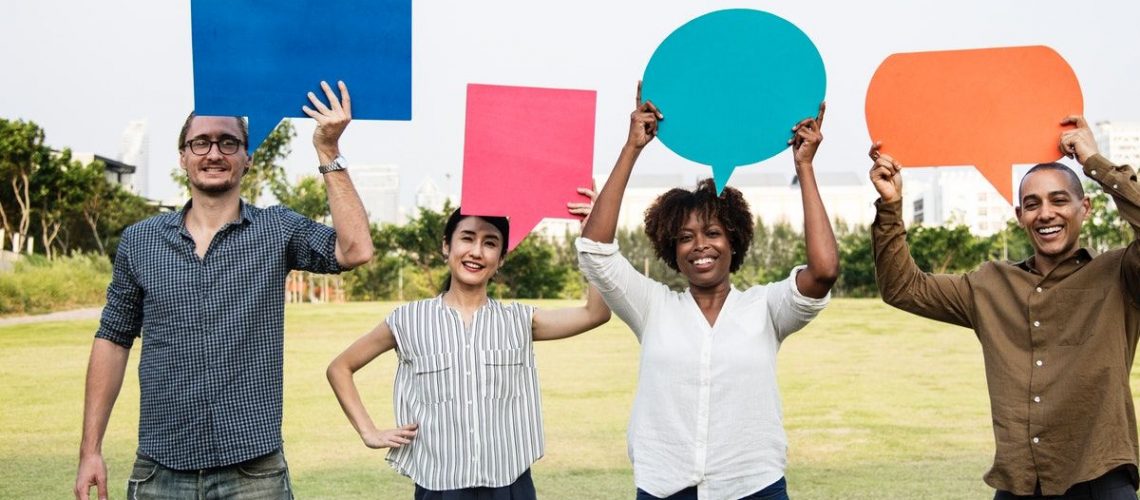I published this article on LinkedIn on January 2, 2021, and I'd like to share it here as well. It is based on a panel discussion at the Warwick Business School (UK) Social Learning Platform and a speech that I gave to the Xavier Institute of Management in Bhubaneswar (India), both in 2020.
Diversity and Inclusion (D&I) are important issues for organizations of today. It can be expressed in terms of gender, ethnicity, religion, politics, handicap, LGBT+, etc. A major barrier to achieving D&I is biased. This article discusses the benefits of D&I, and the dimensions of bias and outlines some ideas for actions.
In the text below, I use the expression ‘minority’ and ‘majority’ people; ‘majority’ are the people who are considered the norm, while ‘minority’ are the “different” ones. Bias and mechanisms of discrimination are the same, regardless of which type of diversity we are looking at.
Which are the benefits companies look for?
Diversity of ideas – linked to increased creativity and innovation – The organization gets more diverse ideas and/or looks at new ideas from a different point of view. It has happened to me, more than once, that I work on something and someone comes along asking a question from a different viewpoint and suddenly I have a better idea on how to proceed. Lack of diverse points of view can even be dangerous, as shown by the self-driving cars not seeing dark-skinned persons as people (Cuthbertson, 2019). The organization obviously missed out on diverse thinking both in product development and quality/safety control.
Company performance - research shows that companies with diverse leadership will perform better. One study shows that ethnically diverse companies were up to 35% more likely to have an above-average financial return– they also have better talent recruitment, improved customer orientation, higher employee satisfaction, and better decision-making (Hunt, et al., 2015). It makes sense if you think about it. When you develop a strategy for a company, whether that is governance, innovation, sales, growth, etc, you first collect as much information as possible. If you are not inclusive and you only listen to a part of your workforce, then you are building a strategy based on incomplete information. And that is not very clever.
Recruitment – you’ll have a larger pool of people to choose from. You do have to be careful already with the wording in the job adverts, though. Research shows that poorly written job adverts diminish the pool of diverse people applying for a job. An example from the space industry showed the differences between job ads that attract diverse applicants and those which do not. (Dudley & Thiemann, 2020)
Better retention – A “nicer” workplace where everyone feels that they are listened to and that they belong. If people feel included, they are more committed to the organization (Brimhall, 2019). Low retention is a loss of competence and money for an organization.
Legislation or other political pressure – obligation to follow or getting fined/bad reputation. In France, for example, companies over a certain size are obliged to have at least 40% women on the board (Reuters, 2011).
I am of the opinion that inclusion is even more important than diversity. Some organizations think that it is enough to have diversity, but if you do not have inclusion, i.e. only one type of people is listened to or encouraged and supported to develop their careers, you do not get the benefit of different ideas and your diversity is useless.
What is bias?
Bias is beliefs and opinions we have about people without knowing them. It comes from our upbringing, surroundings, experiences, and cultures. It is jumping to conclusions about someone, without really knowing them.
Everyone is biased. For example, a few years ago I had the opportunity to visit Bangalore to give a training class. I was very surprised to find out that coffee is grown in India, as I have always thought of tea in connection with India. This particular bias did not hurt anyone, but it shows how easy it is to believe things without having the facts.
Bias becomes a problem when we act on it. When we judge people without knowing the facts about them. When we assume what competencies people have based on how they look, talk, believe, or behave. In a professional setting, bias against a minority can have a significant negative impact on their work advancement and hence career development.
The impact of bias
Bias works against minorities in three dimensions: expectation, resistance, and the assessment of qualifications (Figure 1).

Figure 1 Dimensions of bias
Firstly, the lower expectations of a minority person.
This lack of expectation can be negative, such as in not believing that a minority person is capable. See for example the following BBC video on a black opera singer. When this man first approached a teacher to learn opera, he was told that there was no point in him studying opera, as “black people’s voices do not fit opera”, according to the teacher. As you can see and hear in the clip, he sings beautifully.
The lack of expectation can also come from a misguided wish from the organization of ‘wanting to be nice’ to the minority person. In the latter case, the organization ends up defining minority people as inferior, just by portraying them as “victims of a system” (Romani, et al., 2019).
Both these expressions of lower expectations mean that a minority person will be assigned to lead a smaller project or a smaller team. With the size of projects and teams considered as a qualification, a sign of importance, this means that the minority person is disadvantaged from the start.
I myself experienced this once when becoming a team leader. It was explained to me that I would not be responsible for the full team because some team members were ‘difficult’. When I moved to my following position, the majority person who took the job after me, got the responsibility for the entire team. That person was expected to be able to handle the situation; I was not. And consequently, I was a less important team leader, only based on the smaller size of the team.
Secondly: minority persons meet more resistance when performing their work. They are subconsciously considered as less important, and since we are all busy, the ‘more important ‘persons go before. And the fact that the minority person is leading a smaller team, or a smaller project aggravates the situation. This can be expressed as people not coming to meetings, not answering requests for information, do not give support or perform tasks requested or aggressively questioning the result from a minority person. An example is shown by the male team leader who accidentally swapped their email signature with a female team member and was surprised by the extra amount of time he had to spend convincing customers of his competence (Rodioniva, 2017). This results in, not only time lost for an individual to advance in their job/career but also time lost for the organization. In the article by Rodioniva (2017), the male team leader estimated that his time advantage from being a man was about 30%. For a month’s work (160h), the female will then have advanced only 112h, purely due to bias. This is a direct loss of 48h for the organization. Per month. When this happens regularly, by the end of a year the organization will have lost a lot of money. Not many people think about this effect of bias.
Thirdly: When having their qualifications assessed for potential employment/promotions within an organization, the qualifications of a minority person will be considered less valuable than those of a majority person.
Research has found organizations using recruitment practices that devaluate the qualifications of minority persons and hire them for positions that they are formally over-qualified for (Romani, et al., 2019).
On the promotion and the pay gap between majority and minority persons, many examples exist (Derous, et al., 2017; Ashton, 2014). Company culture plays in here. An organization might choose a majority person for a post, even though a minority person with equal, or even higher, qualifications is available because the majority person is perceived to better fit the organizational culture. The organizational culture has most often been created by the majority of people and this raises the question of organizational culture vs other (gender, ethnicity, religion, politics, handicap, LGBT+, etc ) culture. What is alignment to company culture and what is bias against minorities? This is a difficult line to balance and there is probably no correct answer that fits all organizations. The organization must find some common ground, where the company culture accepts and values differences. But as long as we are all aware that bias exist and keep that in mind when working with, and when assessing, different people, that is already a step forward. It is the ones who claim that there is no bias or that they themselves are not biased, who are usually the worst at perpetuating bias. Because they are not aware.
Cultural differences can never be an excuse to make a colleague feel uncomfortable, work against someone, or not support them to develop in the organization.
The assessment of qualifications is the dimension of bias that most people talk about. The argument against equality measures for the assessment of qualifications is most often that ‘it is not fair against the majority group. This is an incorrect argument. We have established that a diverse and inclusive workplace will give a better result for the entire organization, i.e. it will mean an improvement for both groups. Therefore, the argument that ‘improving for the minority group is unfair to the majority group’, means that for the majority group it is more important to keep the minority group behind them than it is to see an improvement for themselves. It has been found that the majority of people feel threatened by demands on diversity and inclusion (Dover, et al., 2016). That attitude is against most company policies, at least in companies wanting to be innovative, agile, and successful.
How do you reduce bias and its impact?
At the Warwick Business School (UK), Social Learning Platform, we have developed a model for suggested actions against bias, depending on whether you are a majority or a minority person and whether you are acting as an individual, a team leader, or as an organization (Figure 2).
For a minority person: educate yourself and find a mentor to challenge you to do things you might not have thought about. Discuss the business with your mentor, to give you more knowledge. Ask for detailed and specific G&O feedback. These discussions can be uncomfortable, but you should not be afraid of them. Coach and mentor other minorities. Build up a group of support.
If you are a majority person, check your own bias and work on it. Coach and mentor minority persons and give them space to talk and to work.
If you are a minority team leader, you no doubt have some inspirational stories and useful experiences to share with younger minority colleagues. Work on creating space for minority persons to grow.
A majority team leader needs to work on actively seeking the views of others, especially minorities, and have zero tolerance for discrimination. I would recommend organizing subconscious bias training for the entire team.
An organization first of all must have the intent to achieve D&I. It needs to increase awareness of the benefits of diversity and inclusion and get senior managers involved as sponsors. The work must concentrate on behaviors, not culture (Adams, 2018). Also, it must be taken seriously by all levels of the organization, and there must be a long-term strategy.

Figure 2 Diversity and Inclusion Strategy Matrix (WBS Social Learning Platform, 2020)
Finally, I’d like to paraphrase a lady called Avivah Wittenberg-Cox. She gave a TED talk in 2019 on gender equality. I paraphrase it because the mechanisms of discrimination are the same for all types of bias.
“Stop asking what is the matter with minorities, that makes them unable to progress in their careers. Start asking what is the matter with our organization, if we cannot attract, retain and promote the talent also from minority groups.”
References
Adams, B. B., 2018. Women, Minorities, & Other Extraordinary People - The New Path for Workforce Diversity. s.l.: Greenleaf Book Group.
Ashton, D., 2014. Does Race or Gender Matter More to Your Paycheck? Harvard Business Review, 10 June.
Baker Hughes, 2020. Energy Forward 2019 Report on Corporate Responsibility, Houston: Baker Hughes.
Brimhall, K. C., 2019. Inclusion and Commitment as key pathways between leadership and nonprofit performance. Nonprofit Management & Leadership, 30(1), pp. 31-49.
Brown, C. A., Wakefield, S. E. & Bullock, A. D., 2003. The selection of GP trainees in the West Midlands: second audit of assessment center scores by ethnicity and country of qualification. Medical Teacher, 25(6), pp. 649-653.
Cuthbertson, A., 2019. Self-driving cars are more likely to drive into black people, study claims. [Online]
Derous, E., Pepermans, R. & M., R. A., 2017. Ethnic discrimination during resume screening: Mind the job. Human Relations, 70(7), pp. 860-882.
Dover, T. L., Major, B. & Kaiser, C. R., 2016. Members of high-status groups are threatened by pro-diversity organizational messages. Journal of Experimental Social Psychology, Volume 62, pp. 58-67.
Dudley, J. & Thiemann, H., 2020. Assessing the quality of space job adverts. [Online]
Available at: https://spaceskills.org/job-advert-quality
Hunt, V., Layton, D. & Prince, S., 2015. Diversity matters, s.l.: McKinsey&Company.
Reuters, 2011. France sets quota for women on big companies' boards. [Online]
Available at: https://www.reuters.com/article/us-france-equality-idUSTRE70C5ZA20110113
Rodioniva, Z., 2017. Gender Inequality: What happened when a man and woman switched names at work for a week. [Online]
Available at: https://www.independent.co.uk/news/business/news/gender-inequality-man-woman-switch-names-week-martin-schneider-nicky-knacks-pay-gap-a7622201.html
Romani, L., Holck, L. & Risberg, A., 2019. Benevolent discrimination: Explaining how human resources professionals can be blind to the harm of diversity initiatives. Organization, 26(3), pp. 371-390.
Seppälä, E. & Cameron, K., 2015. Proof That Positive Work Cultures Are More Productive. [Online]
WBS Social Learning Platform, 2020. Diversity and inclusion in the workplace: a pragmatic approach. Coventry: Warwick Business School.


